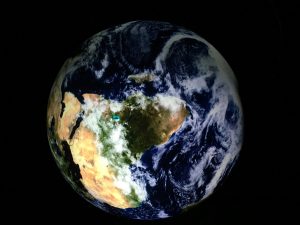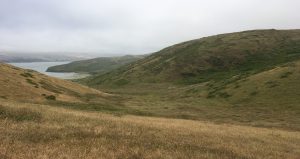
This past Wednesday the field station had the pleasure of hosting about a dozen attendees from the iDigBio conference held at UC Berkeley June 4-6, 2018. The conference focused on the use of data from digitized museum collections and gave attendees from around the world an opportunity to share tools, techniques, discoveries, and outcomes in organismal biology and bioinformatics.
Point Reyes Field Station hosted a field trip to Point Reyes National Seashore so attendees could learn more about the field station and its activities, as well as learn about research being conducted within the national park.

We started our day with a demonstration of the park’s Science on a Sphere, an educational tool for all ages developed by the National Oceanic and Atmospheric Association (NOAA) where real-time data sets are projected onto a striking six-foot diameter globe that hangs from the ceiling. The park’s Chief Scientist, Ben Becker, guided us as we traveled through time by viewing several data sets, including annual migration routes of birds, marine mammals, and sea turtles and captivating views of air traffic patterns around the world (the bursts of 6am flights taking off from airports were pretty cool) and Facebook Friendship connections (and the conspicuous absence of such data from China and Russia). Seeing these datasets presented on the three-dimensional globe gave new meaning to “seeing the big picture” when thinking of global data sets.
Next we headed to the northern part of Point Reyes pensinula, to the historic Pierce Ranch within the Tule Elk Reserve on Tomales Point. The elk did not disappoint, and we spied several separate herds during our time there. The largest herd we saw was the practically ever-present group that spends its time in White Gulch, just east of the trail at aptly-named Windy Gap, a mostly-level one mile walk north of Pierce Ranch.

While in the area we had the chance to see the fenced 36 m x 36 m plots from a twenty-year long elk exclosure experiment. Research from this experiment has looked at the effects of Tule elk on plant community composition, ground-dwelling arthropods, and soil characteristics, among other things. The results from one recent study suggest the elk decrease the abundance non-native perennial bunchgrass, Holcus lanatus (velvet brome), mainly in grassland areas but elk did not prevent the spread of the grass to uninvaded areas.

Baccharis pilularis was putting on a show, with the two different subspecies and their distinctive architectural morphotypes growing side by side along the trail. The shorter, prostrate subspecies, Baccharis pilularis ssp. pilularis, has small leaves and stems that have green, flexible ends with multiple branching nodes and is restricted to the immediate coast. The erect morphotype, Baccharis pilularis ssp. consanguinea, with larger leaves and upright, woody stems grows both along the coast as well as inland parts of the state.

We were also excited to see an active American badger burrow. A California species of special concern, American badger (Taxidea taxus) populations have been increasing in the Seashore in recent years. They are commonly found in grasslands and other areas with soil that provides easy digging and predate on small mammals such as gophers, squirrels, mice, and voles.


Abbott’s Lagoon was our next stop, giving us a chance to botanize and test our luck trying to glimpse the growing population of river otters in the area (they did not show). On our way to check out the dunes to the west we discussed some of the natural history of the area, including the local dialects of the white-crowned song sparrows singing from the tops of Baccharis pilularis (coyote brush) and Lupinus arboreus (yellow bush lupine). The area’s many habitats — coastal scrub, grassland, sand dunes, freshwater and brackish wetlands — provided a wealth of plants to examine.

The trip to Point Reyes National Seashore was a great way to share the ecology and natural history of this national park and a perfect antidote to demanding conference schedules and long days spent in front of computer screens.
